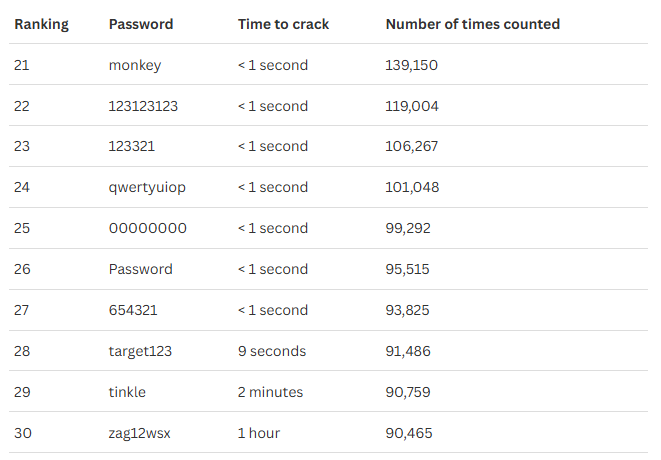Passwords are the digital keys to our lives. From bank accounts to social media profiles, streaming platforms, and even smart devices, passwords guard our personal information. Yet, too often, people choose weak, easily guessable passwords that leave their accounts wide open to hackers. Did you know some passwords can be cracked in under one second? If your go-to password is “123456” or “password,” it’s time to take action.
The Most Common Passwords (and Why They’re a Problem)

Every year, weak passwords top the charts of cybersecurity breaches. For the sixth year in a row, NordPass, an online password manager, has compiled a list of the most common passwords globally. Their research, done in collaboration with NordStellar, analyzed 2.5 terabytes of data from 44 countries, including stolen passwords exposed in data breaches.
Here’s the kicker: many of these passwords can be hacked in less than a second.
Some of the most common offenders include:
- 123456: This has been the most popular password five out of the six years NordPass conducted its study.
- Password: While easy to remember, it’s also easy for hackers to guess.
- Qwerty, abc123, and 111111: These patterns are predictable and incredibly insecure.
Why Do People Choose Weak Passwords?
Let’s face it—passwords are a hassle. Many people stick to simple, memorable options to avoid the frustration of forgetting them. Others reuse the same password across multiple platforms, thinking it’s convenient. The problem? Weak or reused passwords make it a breeze for cybercriminals to access your accounts.
How Hackers Exploit Weak Passwords
Hackers use a variety of methods to crack passwords:
- Brute Force Attacks: Automated programs try every possible combination of characters until they find the right one. Simple passwords like “123456” barely slow them down.
- Credential Stuffing: Hackers use stolen login information from one breach to access other accounts where the same password is used.
- Phishing and Social Engineering: They trick users into revealing passwords by pretending to be legitimate entities.
With these techniques, the most common passwords are a dream for cybercriminals.
How to Create a Strong Password
Creating a strong password doesn’t have to feel like solving a Rubik’s cube. Follow these guidelines to make your passwords virtually unhackable:
- Use at Least 20 Characters: While many platforms only require 8 characters, longer passwords are exponentially harder to crack.
- Mix It Up: Combine uppercase and lowercase letters, numbers, and special symbols like
@,#, and%. - Avoid Personal Information: Don’t use names, birthdays, or any other easily guessable details.
- Choose Random Phrases: A combination of unrelated words like “PurpleBanana$ky2023!” can be memorable and secure.
- Don’t Reuse Passwords: Each account should have its own unique password.
Think of your password like a digital fortress. The more complex it is, the stronger your defenses.
Here are the top 50 most common passwords:





The Best Tools for Managing Passwords
Keeping track of a dozen or more unique, complex passwords can feel impossible. That’s where password managers come in.
- What Is a Password Manager? A password manager securely stores all your passwords in one place. Once you log in, it generates and remembers complex passwords for every account you use. Tools like NordPass or LastPass ensure you only need to remember one master password.
- Are Browser-Saved Passwords Safe? Yes, if used on a personal device. Most modern web browsers offer password-saving features that encrypt your data locally. However, it’s better to rely on dedicated password managers for maximum security.
Tips for Securing Your Passwords
Even with strong passwords and tools, staying vigilant is key:
- Enable Two-Factor Authentication (2FA): Add an extra layer of security by requiring a code sent to your phone or email.
- Change Passwords Regularly: Rotate your passwords every 6-12 months for critical accounts.
- Stay Updated on Breaches: Use websites like Have I Been Pwned to check if your email or passwords have been compromised.
- Don’t Share Passwords: Treat them like secrets. Sharing them, even with friends, increases the risk of exposure.
Why It’s Time to Break Up with “123456”

If you’re still using an insecure password, consider this your wake-up call. Hackers are constantly evolving their tactics, and weak passwords are like an open invitation. A few minutes spent creating a stronger password today could save you hours—or even days—of dealing with a hacked account tomorrow.
Conclusion
Passwords are more than just a minor inconvenience; they’re the frontline of your online security. With hackers able to crack weak passwords in seconds, choosing a strong, unique password is non-negotiable. Use the tips above to bolster your digital defenses, and consider investing in a password manager for peace of mind.
Remember, your password is the key to your digital life. Make it strong, make it unique, and never underestimate its importance. Now, go on—ditch “123456” and give hackers a run for their money!


